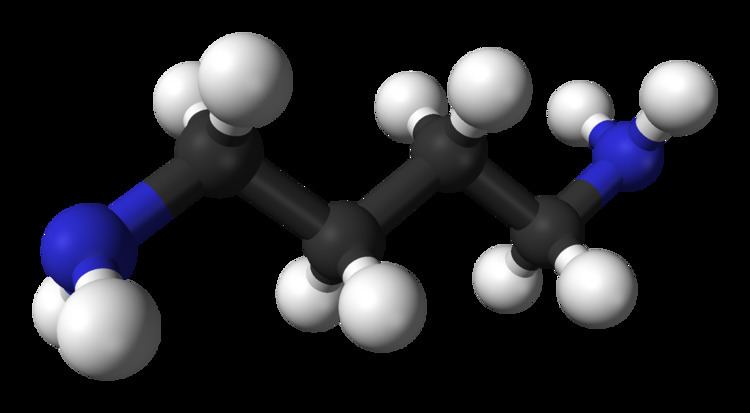3DMet B00037 Boiling point 159 °C | Formula C4H12N2 Appearance Colourless crystals | |
 | ||
Related alkanamines Related compounds | ||
Carcinogenic putrescine
Putrescine, or tetramethylenediamine, is a foul-smelling organic chemical compound NH2(CH2)4NH2 (1,4-diaminobutane or butanediamine) that is related to cadaverine; both are produced by the breakdown of amino acids in living and dead organisms and both are toxic in large doses. The two compounds are largely responsible for the foul odor of putrefying flesh, but also contribute to the odor of such processes as bad breath and bacterial vaginosis. They are also found in semen and some microalgae, together with related molecules like spermine and spermidine.
Contents
- Carcinogenic putrescine
- Combustion analysis putrescine
- History
- Production
- Biochemistry
- Toxicity
- References
Combustion analysis putrescine
History
Putrescine and cadaverine were first described in 1885 by the Berlin physician Ludwig Brieger (1849–1919).
Production
Putrescine is produced on an industrial scale by hydrogenation of succinonitrile, which is produced by addition of hydrogen cyanide to acrylonitrile. Putrescine is reacted with adipic acid to yield the polyamide Nylon 46, which is marketed by DSM under the trade name Stanyl. Biotechnological production of putrescine from renewable feedstock is a promising alternative to the chemical synthesis. A metabolically engineered strain of Escherichia coli that produces putrescine at high titer in glucose mineral salts medium has been described.
Biochemistry
Spermidine synthase uses putrescine and S-adenosylmethioninamine (decarboxylated S-adenosyl methionine) to produce spermidine. Spermidine in turn is combined with another S-adenosylmethioninamine and gets converted to spermine.
Putrescine is synthesized in small quantities by healthy living cells by the action of ornithine decarboxylase.
Putrescine is synthesized biologically via two different pathways, both starting from arginine.
The polyamines, of which putrescine is one of the simplest, appear to be growth factors necessary for cell division.
Toxicity
Putrescine is toxic in large doses. In rats it has a low acute oral toxicity of 2000 mg/kg body weight, with no-observed-adverse-effect level of 2000 ppm (180 mg/kg body weight/day).
